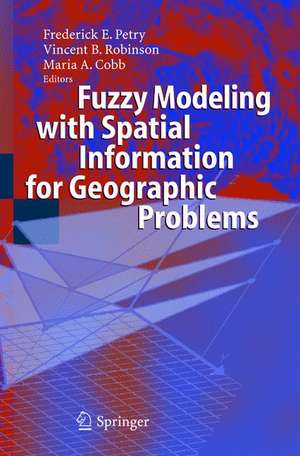Fuzzy Modeling with Spatial Information for Geographic Problems
Editat de Frederick E. Petry, Vincent B. Robinson, Maria A. Cobben Limba Engleză Hardback – 14 feb 2005
| Toate formatele și edițiile | Preț | Express |
|---|---|---|
| Paperback (1) | 1219.46 lei 6-8 săpt. | |
| Springer Berlin, Heidelberg – 14 oct 2010 | 1219.46 lei 6-8 săpt. | |
| Hardback (1) | 1227.04 lei 6-8 săpt. | |
| Springer Berlin, Heidelberg – 14 feb 2005 | 1227.04 lei 6-8 săpt. |
Preț: 1227.04 lei
Preț vechi: 1496.40 lei
-18% Nou
Puncte Express: 1841
Preț estimativ în valută:
234.82€ • 254.98$ • 197.25£
234.82€ • 254.98$ • 197.25£
Carte tipărită la comandă
Livrare economică 22 aprilie-06 mai
Preluare comenzi: 021 569.72.76
Specificații
ISBN-13: 9783540237136
ISBN-10: 3540237135
Pagini: 350
Ilustrații: XII, 338 p.
Dimensiuni: 155 x 235 x 22 mm
Greutate: 0.71 kg
Ediția:2005
Editura: Springer Berlin, Heidelberg
Colecția Springer
Locul publicării:Berlin, Heidelberg, Germany
ISBN-10: 3540237135
Pagini: 350
Ilustrații: XII, 338 p.
Dimensiuni: 155 x 235 x 22 mm
Greutate: 0.71 kg
Ediția:2005
Editura: Springer Berlin, Heidelberg
Colecția Springer
Locul publicării:Berlin, Heidelberg, Germany
Public țintă
ResearchCuprins
Reasoning About Regions, Relations, and Fields.- Fuzzy Reasoning about Geographic Regions.- Combined Extraction of Directional and Topological Relationship Information from 2D Concave Objects.- Field Based Methods for the Modeling of Fuzzy Spatial Data.- Modeling Localities with Fuzzy Sets and GIS.- Fuzzy Classification.- Mining Weather Data Using Fuzzy Cluster Analysis.- Modelling the Fuzzy Spatial Extent of Geographical Entities.- Multi-Dimensional Interpolations with Fuzzy Sets.- Talking Space — A Social & Fuzzy Logical GIS Perspective On Modelling Spatial Dynamics.- A Valuation of the Reliability of a GIS Based on the Fuzzy Logic in a Concrete Case Study.- Fuzzy Representations of Landscape Features.- Fuzziness and Ambiguity in Multi-Scale Analysis of Landscape Morphometry.- Fuzzy Representation of Special Terrain Features Using a Similarity-based Approach.- Decision Making with GIS and Fuzzy Sets.- Spatial Decision-Making Using Fuzzy Decision Tables: Theory, Application and Limitations.- Spatial Decision Making Using Fuzzy GIS.- Spatially Explicit Individual-Based Ecological Modeling with Mobile Fuzzy Agents.
Recenzii
From the reviews:
"Fuzzy Modelling … is a collection of papers of diverse but interrelated topics on the use of fuzzy logic … . The reader is given enough information and references … . this book will provide an excellent background on fuzzy logic and how it can be applied to a variety of spatial problems. It is also a valuable information source for professors, graduate students or industry professionals, and it should be on their bookshelves or at least in the library." (Alvin Simms, Geomatica, Vol. 60 (4), 2006)
"Fuzzy Modelling … is a collection of papers of diverse but interrelated topics on the use of fuzzy logic … . The reader is given enough information and references … . this book will provide an excellent background on fuzzy logic and how it can be applied to a variety of spatial problems. It is also a valuable information source for professors, graduate students or industry professionals, and it should be on their bookshelves or at least in the library." (Alvin Simms, Geomatica, Vol. 60 (4), 2006)
Textul de pe ultima copertă
Over recent years, interest in using fuzzy sets approaches has grown across fields that use spatial information in geographic problems. Not only has there been considerable research on fuzzy sets in GIS that support geographic problem solving, but increasingly the uncertainties inherent in modeling geographic problems are addressed using soft-computing methods. This book focuses on research advances in approaches for incorporating explicit handling of uncertainty, especially by fuzzy sets, to address geographic problems. It has two aims: to stimulate research in the theory and application of fuzzy sets to spatial information management and geographic problem solving; and to highlight advances that have matured so much that geoscientists, computer scientists, geographers, et al. use fuzzy modeling. The book includes examples of the use of fuzzy sets in representational issues such as terrain features, landscape morphology, spatial extents and approaches for spatial interpolation, plus applications using fuzzy sets covering data mining, spatial decision making, ecological simulation, and reliability in GIS.
Caracteristici
First book collecting a broad spectrum of research on geographic information uncertainty using Fuzzy Modeling Includes supplementary material: sn.pub/extras












